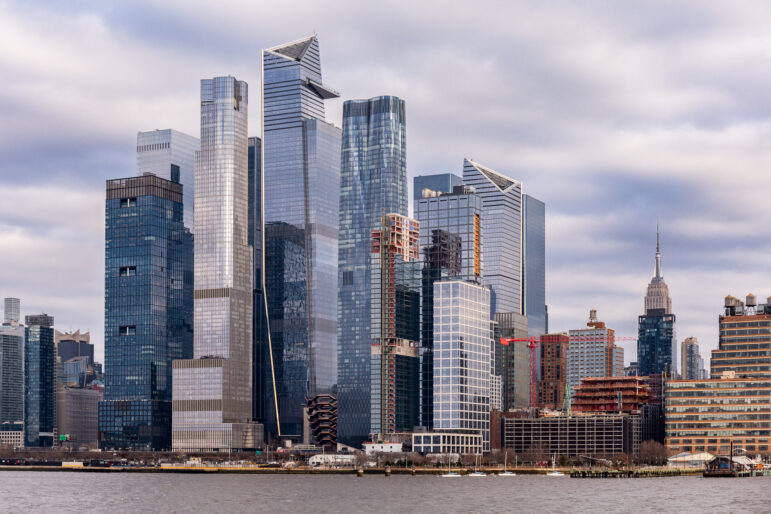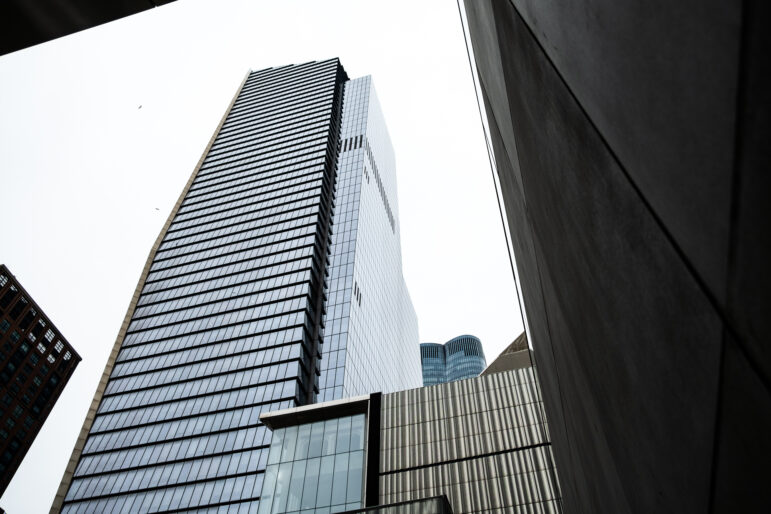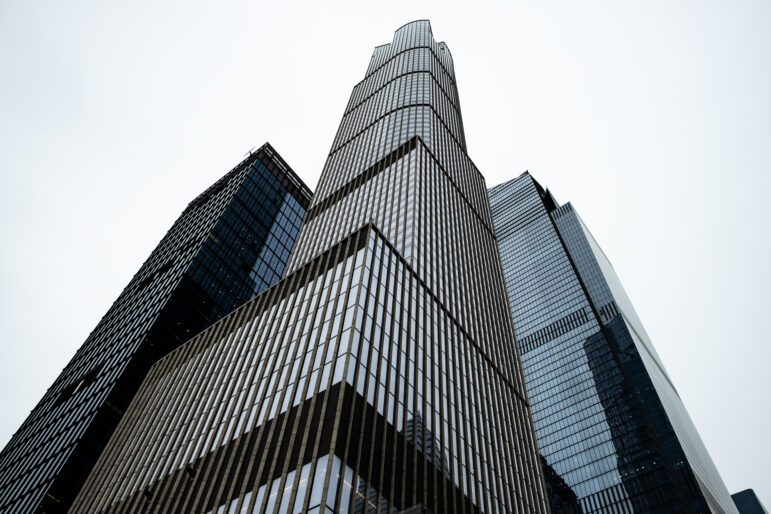Hudson Yards promised to be one of the most efficient sustainable neighborhoods in the U.S. But public energy consumption data tracked by the city shows many green-certified properties in the neighborhood are failing to outperform similar buildings nationwide.

Adi Talwar
A view of the Hudson Yards neighborhood from the Hudson River.When Manhattan’s 60 block business district, Hudson Yards, emerged into New York City’s skyline in 2019, it promised to be more than just another jungle of upscale skyscrapers draped in sleek glass and steel.
The $25 billion project was marketed by real estate developers Related Companies and Oxford Property Group as a cutting edge sustainable neighborhood, even boasting state-of-the-art generators that recapture excess heat to both heat and cool its buildings.
The developers said they aimed “to become the most connected, sustainable, responsive and efficient neighborhood in the U.S.” To make it official, a 28-acre portion of the complex known as the Eastern Yard became the first neighborhood in Manhattan to receive a Gold certificate from LEED, the world’s most widely used green building certification system. Created by the non-profit U.S Green Building Council (USGBC), the Gold certificate is the second highest honor bestowed by the organization.
LEED upholds energy efficiency as its highest standard and guarantees that its certified properties consume 25 percent less energy compared to conventional buildings. The less energy a building consumes, the less greenhouse gasses they emit.
But many green-boasting buildings in Hudson Yards are less energy efficient than similar buildings nationwide, according to public city data and interviews with environmentalists. A City Limits review of 27 LEED-certified buildings in the neighborhood found that fewer than half scored above the median range under the city’s own efficiency rating system.
With over 70 percent of New York’s greenhouse gas emissions coming from buildings, experts who spoke to City Limits said it put into question how exactly we define sustainability at a time when Eric Adams “City of Yes” pushes for a more energy efficient city, and a wave of new development.
“I see the same story in all of those buildings. They are very big, they are very flashy, they are LEED Platinum, which is the fanciest LEED rating you can get, and they produce high levels of greenhouse emissions,” said Richard Leigh, engineer and former research director at Urban Green Council, a nonprofit pushing for New York to decarbonize its building stock.
‘They’re not really saving the planet’
Leigh came to the conclusion that many LEED-decorated skyscrapers in New York City are still heavier carbon emitters by sifting through public data made available through Local Law 84. The law requires owners of large buildings to annually measure and disclose their energy and water consumption in a process called benchmarking.
The benchmarking data was used by decision makers when crafting the city’s ambitious plans to reduce 80 percent of large buildings’ greenhouse emissions by 2050 under Local law 97.
The city’s Department of Buildings also uses this data to come up with an annual progress report on how much energy these buildings are consuming. They adopted a federal system called Energy Star to compare a building’s energy consumption to similar buildings nationwide and rate their performance on a scale from 1 to 100.

Adi Talwar
An energy grade posted in the window of a building on 37th Street in Manhattan between 9th and 10th avenues.
New York City added a corresponding letter grade from A to D, like teachers do in schools. If a property earns a “C”, for example, that means it’s earned a median score (from 55 to 70 on Energy Star’s scale) when compared to other constructions like it nationwide. Anything below 55 earns a “D.” An “F” signifies that the building owner didn’t submit the required information, according to the city’s rubric.
Thanks to Local Law 33, buildings are required to display that grade near a public entrance for all to see.
The point, according to an Energy Star spokesperson, is to give landlords a snapshot of how their buildings are doing every year so that they can “benchmark and compare their energy performance,” and strive to improve it. “Improvement in energy efficiency reduces greenhouse gas emissions,” the spokesperson said in an email.
While the city’s rating system tracks a building’s energy efficiency yearly, LEED grants green status for life without requiring properties keep up with those standards over the long term. Once it’s been LEED-certified, a building can’t lose its certification, even as governments—including New York’s—set new and stricter emissions benchmarks to combat the increasing threat of climate change.
“The problem is that while LEED can accommodate [long-term] high performance, it doesn’t require it,” Leigh said. “People can build a LEED Platinum building [that has] a low Energy Star score and high greenhouse gas emissions, and I think that’s a major flaw in LEED ratings.”
Founded in 1994, LEED has for years been criticized by environmentalists for not holding buildings accountable for meeting energy efficiency standards in the long run. In 2009, under mounting pressure from the public, the USGBC said it would begin requiring the owners of LEED-certified buildings to submit annual energy-use data for the first five years of occupancy. But scientists who spoke to City Limits said they are yet to gain access to those numbers.
LEED spokesperson Deisey Verdinez said that the rating system does have a program for buildings to track their performance that can be accessed by the public, but added that because it’s a voluntary system, “some projects don’t always remember to upload their information on there.”
But their focus is not on keeping track of long term performance. The certificate, spokesperson Deisey Verdinez explains, represents “a stamp in time” in which these properties met sustainability requirements. There are an estimated 1,400 LEED certificates in New York City, according to data provided by USGBC.
“It’s sort of like a health journey. Let’s say, you meet all your health goals at one point, but it’s on you to continue to sustain them,” Verdinez told City Limits.
Kurt Steiner, urban planner and a LEED specialist at USGBC, added that the rating system “sets a building up for success,” but after that it’s up to “the owner, the property manager and the occupants to ensure that the building is performing to its best potential.”
Environmentalists warn, however, that this encourages landlords to get the initial sustainability certificate—and the positive PR that comes with it—without ensuring their building is energy efficient over time. As a result, Leigh says that “LEED has just become a marketing tool” that high-end real estate developers and major companies use “to be seen as sustainable.”
To issue its certification, LEED uses a scorecard that allows properties to accumulate sustainability points in a wide range of criteria like air quality, rainwater management, innovation and even transportation. Having a bike rack in the building, for instance, earns a landlord one point. Environmentalists say that means it’s possible to accumulate points and get certified without committing to long-term energy savings.
John Scofield, a physics professor at Oberlin College, studied the energy efficiency of LEED-certified properties by examining their energy consumption using the city’s public benchmarking data. A study he published in 2021 that looked at 10 major U.S cities, including New York, found that on average LEED office buildings were using 7 percent less primary energy and had 7 percent lower carbon emissions than similar buildings in the same cities.
This figure, Scofield points out, is way below the LEED promise of delivering buildings that consume 25 percent less energy. New York City LEED offices had the highest total energy consumption out of all 10 cities and according to Scofield, “showed no significant savings over non-LEED NYC offices.”
“They’re not really saving the planet,” Scofield told City Limits. “Some LEED buildings can be very efficient, but you can also have one that checks all the boxes [in their sustainability criteria] and in the end isn’t very energy efficient.”
Making the grade
In January of 2018, developers Related Companies and Oxford Properties Group announced the opening of the neighborhood's first commercial building, 10 Hudson Yards. The gleaming blue-glass tower was anointed the first commercial office building in New York to receive LEED Platinum certification.
"We’re proud to take a leadership approach to sustainability that creates value for our partners while doing what’s right for the planet," said Blake Hutcheson, president and CEO of Oxford Properties Group in a press release. Oxford did not respond to City Limits requests for comment for this story.
LEED certifications are powered by a point-based system. To obtain LEED's platinum status, a property must earn 80 sustainability points, with different values assigned to each green feature a project includes, and with energy performance holding the most weight. USGBC told City Limits that all its projects must outperform the energy efficiency baseline set by the national building energy code standard.
In 2019, Real Estate Weekly called 10 Hudson Yards "one of the city’s most energy-efficient Class A office towers."
A spokesperson for Related Realty said in an email that to this day 10 Hudson Yards generates power, hot water and chilled water with twice the efficiency of standard systems.

But the city's Building Energy Efficiency Rating system gave the building a "C" grade, which means it’s displaying a midrange energy performance when compared to other buildings like it. Another of Related's highly rated LEED-Certified properties, 55 Hudson Yards—where companies like the technology giant Meta, the law firm Cooley and hedge fund Point72 have their offices—also has a "C" rating.
And some are doing worse. Related Realty's luxury apartment complex, Abington House, which is located on 30th Street, has a Gold LEED certificate and a "D" energy efficiency rating. The Gold-certified 35 Hudson Yards also has a "D" grade. The location is home to Related Realty's gym, an office space and an Equinox hotel.
Through a spokesperson, Related took issue with the city’s Energy Star rating, saying the national data set of buildings the system compares a property’s performance to is at odds with the conditions of many New York buildings, particularly densely-occupied high-rises that operate for longer hours and will inevitably use more energy.
That criticism echoes complaints from the real estate sector when Local Law 33 was first passed. “Some buildings may choose to discourage density and high intensity energy uses to improve their grades,” the Real Estate Board of New York warned in 2017 City Council testimony.
“Hudson Yards is a model of environmentally-friendly design and continues to lead when it comes to new ways to limit emissions, promote reuse, and ensure resiliency,” a Related spokesperson said in an email.
City Limits looked up the Energy Star scores for the 27 LEED-certified properties in Hudson Yards using data provided by USGBC. According to the 2005 rezoning which established the neighborhood, that includes the area bounded roughly by West 42nd Street and West 30th Street, Eighth Avenue to the Hudson River.
City Limits found that fewer than half of the LEED-certified properties in the neighborhood had scored above the median under the city’s ratings.
In total, 11 had an "A" or "B" score from the city, while the rest had a "C" rating or lower or were exempt from showing their scores altogether. Those exemptions apply to seven of Hudson Yards' LEED buildings, including the Javits Convention Center, and are guaranteed by the benchmarking law for properties that have a "data center, television studio, and/or trading floor that together exceed ten percent of the property's Gross Floor Area (GFA)"—uses known for their above-average energy consumption.
A spokesperson for the city's accelerator program, which tracks the local Energy Star scores, said in an email that there is no "further explanation" as to why the law allows for these exemptions. But a city official who asked to remain anonymous told City Limits that these commercial buildings get a pass because their "energy consumption is astronomical" and will likely display a poor score.

Given these exemptions, Scofield, the physics professor who has also done extensive research on the Energy Star program, warned that it can also be "highly problematic."
"A lot of these things come out of good intentions. But in the end, they're not producing the desired result to lower greenhouse gas emissions," Scofield said.
British architect Andrew Waugh told City Limits that the Australian rating system Nabers is making strides in terms of determining the energy efficiency of buildings over time. The system, according to the architect, measures the amount of energy a building has used over a two-year period and compares that energy use to the sustainability claims that were made pre-construction.
We need to be using ‘less stuff’
Waugh, whose firm builds primarily with environmentally sustainable materials around the world, said there is one main reason why many LEED-decorated buildings don't perform well over time: LEED promotes the use of "complex building management systems" that use too much "technology" which ends up wasting more energy than it saves.
"So the whole building is controlled by computers rather than the people that are in the building. All the heating or cooling inside the building is controlled," Waugh explains.
Many office buildings for example, like the ones in Hudson Yards, are glass encased air-tight spaces where people can't crack a window in the summer. Instead, a central operating system cranks up the air conditioning, wasting energy and forcing everyone inside to wear a sweater.
Landlords and developers, Waugh said, often end up blaming a building’s occupants for not knowing how to use these systems properly, rather than invest in more energy efficient designs and fewer gadgets. "We need to work out how we can adapt our architecture, our construction processes to use less carbon and use less stuff," Waugh said.
This year, his firm inaugurated the Black and White Building in London, a structure made entirely out of wood for the Office Group, a company owned by Blackstone, the world's largest corporate landlord. Sustainable timber, Waugh said, can be grown in a dedicated forest and replanted.
"Then our building becomes a carbon store rather than a carbon burden," he explained.
For decades developers in New York City have been constructing technology-driven glass encased skyscrapers. One such techno-savvy building is the Bank of America tower located at One Bryant Park. A LEED platinum building, the property was marketed by developer Douglas Durst as the most sustainable in the country when it opened its doors in 2010.
But now, the building is en route to fail the first compliance goal for reducing emissions set by Local Law 97 and faces an annual fine of over $1.6 million unless they can dramatically reduce its energy consumption, according to the Building Energy Exchange's penalty calculator. Durst did not respond to a request for comment for this story.
"This kind of Wall Street modernism has given us the idea that we can build whatever we want, because we have the technology to surpass nature and climate. What the planet is showing us is that we don't," Waugh said.
One way to get developers to change how they design buildings is to rethink the certification systems that encourage people to go green in the first place.
"It's not clear to me that the LEED designation is a huge leap forward from standard development practices," said Stuart Brodsky, who teaches at New York University’s Institute of Real Estate and previously worked in the real estate investment unit at General Electric Capital.
"It may be a good incremental step forward. And it has a very popular and celebrated name with it, but I'm betting we can do a lot better," the real estate professor added.
Brodsky agrees with other experts that having an efficient, and transparent mechanism to track a building's energy performance over time can help developers move towards more sustainable goals.
"If your building is LEED Platinum, that's a pretty remarkable engineering achievement. That's a very complicated building,” he said. “But that doesn't mean the building's energy efficiency persists. And without measurement strategies that require public disclosure in place, we'll never know."









3 thoughts on “Hudson Yards Calls Itself a Model Neighborhood for Energy Efficiency. City Data Paints a Different Picture”
Excellent analysis and discussion!
It throws light on the pronounced tendency to greenwash the new trophy buildings and high rise meccas.
An additional analysis that looks at the low occupancy rates in Hudson Yards and other new megastructures would yield yet another example of greenwashing: if you calculate energy use per inhabitant (or user) the result may be disappointing.
I agree that an effective and transparent solution for tracking energy efficiency plays an important role here, as developers who really want to make buildings more environmentally friendly cannot always realize this because they lack control.
In this case, such seemingly perfect building designs may not be able to significantly reduce energy consumption.
I have built a high performance building. LEED is a terrible gimmick. 1. Get south facing exposure north of the equator. Minimize east, west and southern exposures. 2. Insulate and weatherization (zero drafts) this is not difficult and has quick ROI forever.
Utilities and their stockholders dislike energy conservation.